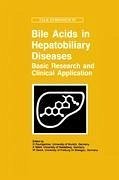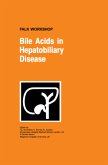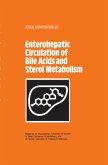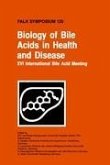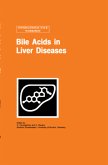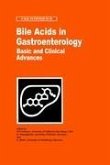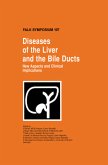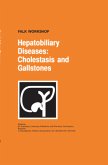Paumgartner
Bile Acids and Hepatobiliary Diseases - Basic Research and Clinical Application
Herausgegeben:Paumgartner, G.; Stiehl, A.; Gerok, W.
Paumgartner
Bile Acids and Hepatobiliary Diseases - Basic Research and Clinical Application
Herausgegeben:Paumgartner, G.; Stiehl, A.; Gerok, W.
- Gebundenes Buch
- Merkliste
- Auf die Merkliste
- Bewerten Bewerten
- Teilen
- Produkt teilen
- Produkterinnerung
- Produkterinnerung
Since the last International Bile Acid Meeting in San Diego in 1994, new advances have been made in the understanding of bile acid metabolism and transport. The cytotoxic as well as the therapeutic effects of specific bile acids have been further explored and the beneficial effects of ursodeoxycholic acid in various chronic cholestatic conditions have been substantiated. Much basic and clinical research has been conducted to unravel the underlying mechanisms of action. This volume, the proceedings of Falk Symposium No. 93 (XIV International Bile Acid Meeting), held in Freiburg-im-Breisgau,…mehr
Andere Kunden interessierten sich auch für
![Bile Acids in Hepatobiliary Disease Bile Acids in Hepatobiliary Disease]() NorthfieldBile Acids in Hepatobiliary Disease121,99 €
NorthfieldBile Acids in Hepatobiliary Disease121,99 €![Enterohepatic Circulation of Bile Acids and Sterol Metabolism Enterohepatic Circulation of Bile Acids and Sterol Metabolism]() PaumgartnerEnterohepatic Circulation of Bile Acids and Sterol Metabolism161,99 €
PaumgartnerEnterohepatic Circulation of Bile Acids and Sterol Metabolism161,99 €![Biology of Bile Acids in Health and Disease Biology of Bile Acids in Health and Disease]() van Berge HenegouwenBiology of Bile Acids in Health and Disease121,99 €
van Berge HenegouwenBiology of Bile Acids in Health and Disease121,99 €![Bile Acids in Liver Diseases Bile Acids in Liver Diseases]() G. Paumgartner / U. Beuers (eds.)Bile Acids in Liver Diseases121,99 €
G. Paumgartner / U. Beuers (eds.)Bile Acids in Liver Diseases121,99 €![Bile Acids in Gastroenterology: Basic and Clinical Advances Bile Acids in Gastroenterology: Basic and Clinical Advances]() A.F. Hofmann / G. Paumgartner / A. Stiehl (Hgg.)Bile Acids in Gastroenterology: Basic and Clinical Advances201,99 €
A.F. Hofmann / G. Paumgartner / A. Stiehl (Hgg.)Bile Acids in Gastroenterology: Basic and Clinical Advances201,99 €![Diseases of the Liver and the Bile Ducts Diseases of the Liver and the Bile Ducts]() J. Spic k / J.L. Boyer / T. Gilat / J. Kotrlik / Z. Marecek / G. Paumgartner (Hgg.)Diseases of the Liver and the Bile Ducts161,99 €
J. Spic k / J.L. Boyer / T. Gilat / J. Kotrlik / Z. Marecek / G. Paumgartner (Hgg.)Diseases of the Liver and the Bile Ducts161,99 €![Hepatobiliary Diseases: Cholestasis and Gallstone Hepatobiliary Diseases: Cholestasis and Gallstone]() M. Acalovschi / G. Paumgartner (Hgg.)Hepatobiliary Diseases: Cholestasis and Gallstone81,99 €
M. Acalovschi / G. Paumgartner (Hgg.)Hepatobiliary Diseases: Cholestasis and Gallstone81,99 €-
-
-
Since the last International Bile Acid Meeting in San Diego in 1994, new advances have been made in the understanding of bile acid metabolism and transport. The cytotoxic as well as the therapeutic effects of specific bile acids have been further explored and the beneficial effects of ursodeoxycholic acid in various chronic cholestatic conditions have been substantiated. Much basic and clinical research has been conducted to unravel the underlying mechanisms of action.
This volume, the proceedings of Falk Symposium No. 93 (XIV International Bile Acid Meeting), held in Freiburg-im-Breisgau, Germany, October 22-24, 1996, is dedicated to both basic and clinical aspects of bile acid research related to the role of bile acids in hepatobiliary diseases.
Hinweis: Dieser Artikel kann nur an eine deutsche Lieferadresse ausgeliefert werden.
This volume, the proceedings of Falk Symposium No. 93 (XIV International Bile Acid Meeting), held in Freiburg-im-Breisgau, Germany, October 22-24, 1996, is dedicated to both basic and clinical aspects of bile acid research related to the role of bile acids in hepatobiliary diseases.
Hinweis: Dieser Artikel kann nur an eine deutsche Lieferadresse ausgeliefert werden.
Produktdetails
- Produktdetails
- Falk Symposium 93
- Verlag: Springer / Springer Netherlands
- Artikelnr. des Verlages: 978-0-7923-8725-1
- 1997.
- Seitenzahl: 352
- Erscheinungstermin: 30. Juni 1997
- Englisch
- Abmessung: 241mm x 160mm x 24mm
- Gewicht: 676g
- ISBN-13: 9780792387251
- ISBN-10: 0792387252
- Artikelnr.: 23141104
- Herstellerkennzeichnung Die Herstellerinformationen sind derzeit nicht verfügbar.
- Falk Symposium 93
- Verlag: Springer / Springer Netherlands
- Artikelnr. des Verlages: 978-0-7923-8725-1
- 1997.
- Seitenzahl: 352
- Erscheinungstermin: 30. Juni 1997
- Englisch
- Abmessung: 241mm x 160mm x 24mm
- Gewicht: 676g
- ISBN-13: 9780792387251
- ISBN-10: 0792387252
- Artikelnr.: 23141104
- Herstellerkennzeichnung Die Herstellerinformationen sind derzeit nicht verfügbar.
Adolf-Windaus-Award 1996; W. Gerok. Adolf-Windaus-Prize Lecture: Bile Acid
Transport Systems as Pharmaceutical Targets; W. Kramer. I: Bile Acid
Biosynthesis and Metabolism. 1. Determinants of Biliary Bile Acid
Composition in Mammals: Influence of Age and Gender; M. Gavrilkina, et al.
2. Identification of a Unique Inborn Error in Bile Acid Conjugation
Involving a Deficiency in Amidation; K.D.R. Setchell, et al. 3. Regulation
of Sterol 27-Hydroxylase and Its Role in the Regulation of `acidic' Pathway
of Bile Acid Synthesis; Z.R. Vlahcevic, et al. 4. Sterol
12alpha-hydroxylase: a Key Cytochrome P-450 in Bile Acid Synthesis. Cloning
and Expression of the Rabbit Enzyme; G. Eggertsen, et al. 5.
Stereochemistry of Peroxisomal Side-Chain Degradation in Bile-Salt
Biosynthesis; W. Dieminger, et al. 6. Does Cisapride Overcome the Effects
of Octreotide on Intestinal Transit, Thereby Reducing the Proportion of
Deoxycholic Acid in Bile and Serum? M.J. Vesey, et al. II: Hepatic Bile
Acid Transport. 7. Regulation of Bile Acid Carrier Expression in Normal and
Diseased Liver; P.J. Meier. 8. Regulation of the Organic Anion Transporting
Polypeptide of Human Liver; G.A. Kullak-Ublick, et al. 9. Regulation of
Bile Acid Transporters in Experimental Cholestasis; C. Gartung, J.L. Boyer.
10. Regulation of Hepatocyte Bile Salt Transporters by Endotoxin and
Cytokines; R.M. Green, J.L. Gollan. 11. ATP-Binding Cassette Proteins and
the Molecular Basis of Liver Cell Membrane Transport; N. Lomri, et al. 12.
ATP-Dependent Transport of Dianionic Bile Salts by the Canalicular Isoform
of the Multidrug Resistance Protein (MRP2/cMRP/cMOAT); D. Keppler, et al.
13. Cloning and Characterization of cMOAT, a Transporter for Divalent
Anionic Bile Salts; C.C. Paulusma, et al. 14. Stimulation of Bile Acid
Secretion by Tauroursodeoxycholate and Cell Swelling Involves
Mitogen-Activated Protein Kinase; D. Häussinger, et al. III: Intestinal
Bile Acid Transport. 15. The Molecular Genetics of Ileal Bile Acid
Transport; P.A. Dawson, P. Oelkers. 16. Properties and Specificity of the
Rabbit Ileal Na+/Bile Acid Cotransport System; W. Kramer, et al. 17.
Regulation of the Sodium-Dependent Ileal Bile Acid Transporter in the Rat;
R.T. Stravitz, et al. 18. Effect of Cholestasis on Ileal and Jejunal
Absorption of Bile Acids in Rat; P. Sauer, et al. 19. Cloning and
Characterization of a Regulon Involved in Bile Acid Transport and
7-Dehydroxylation in an Intestinal Eubacterium Species; D.H. Mallonee,
P.B. Hylemon. IV: Biological Actions of Bile Acids. 20. Effects of Bile
Acids on Bile Secretion; J.L. Boyer. 21. Modulation of Hepatocellular
Signaling by Bile Acids; U. Beuers, et al. 22. Ursodeoxycholate Activates
Ca2+-dependent Cl- currents in a Human Biliary Cell Line; R. Roman, et al.
23. Bile Salt Stimulation of Biliary Phospholipid Secretion; J.M. Crawford.
24. Organic Anions Do Not Impair Bile Salt Micellization in In Vitro Model
Bile Systems: Implications for the Mechanism of Organic Anion-Induced
Inhibition of Biliary Lipid Secretion In Vivo; H.J. Verkade, et al. 25.
Antioxidant Properties of Bile Acids Evaluated with Enhanced
Chemiluminescent Assay: A Possible Physiological Role; A. Roda, et al. 26.
Bile Salt Induces Alterations in Bilayer Permeability: Insights Into
Cytoprotection and Cytotoxicity; A. Albalak, et al. 27. Effector Proteases
in Bile Salt-Induced Hepatocyte Apoptosis; L.R. Roberts, et al. 28.
Borderline Pathology in mdr2(-l-) Rescue Mice: A New Model to Study
Non-Suppurative Cholangitis; M. de Vree, et al. 29. Effects of Deoxycholic
Acid on Cholesterol and Bile Acid Metabolism in Human Liver; C. Einarsson,
et al. 30. Bile Acids Modulate the Interferon Signalling Pathway; P.
Podevin, et al. 31. Obstructive Cholestasis Inhibits the Rate of
Cholesterol 7&agr;-Hydroxylation in Humans In Vivo; M. Bertolotti, et al.
V: Bile Acids in Therapy. 32. Multi-Drug Treatment for Primary Biliary
Cirrhosis: Is More Better?; B.J.F. van Hoogstraten, et al. 33.
Ursodeoxycholic Acid in Combination with Prednisolone or Budenoside in the
Therapy of Primary Biliary Cirrhosis; U. Leuschner, et al. 34. Bile Acid
Synthesis, Metabolism and Secretion in Primary Biliary Cirrhosis Before and
After Steroid and Colchicine Treatment; E. Roda, et al. 35. Medical
Treatment of Primary Sclerosing Cholangitis: On the Role of Ursodeoxycholic
Acid; A. Stiehl, et al. 36. Ursodeoxycholic Acid in the Treatment of
Cholestasis of Pregnancy; J. Palma, et al. 37. Clinical Outcome of
Long-Term Treatment of Ursodeoxycholic Acid in Patients with Cystic
Fibrosis-Associated Liver Disease; C. Colombo, et al.
Transport Systems as Pharmaceutical Targets; W. Kramer. I: Bile Acid
Biosynthesis and Metabolism. 1. Determinants of Biliary Bile Acid
Composition in Mammals: Influence of Age and Gender; M. Gavrilkina, et al.
2. Identification of a Unique Inborn Error in Bile Acid Conjugation
Involving a Deficiency in Amidation; K.D.R. Setchell, et al. 3. Regulation
of Sterol 27-Hydroxylase and Its Role in the Regulation of `acidic' Pathway
of Bile Acid Synthesis; Z.R. Vlahcevic, et al. 4. Sterol
12alpha-hydroxylase: a Key Cytochrome P-450 in Bile Acid Synthesis. Cloning
and Expression of the Rabbit Enzyme; G. Eggertsen, et al. 5.
Stereochemistry of Peroxisomal Side-Chain Degradation in Bile-Salt
Biosynthesis; W. Dieminger, et al. 6. Does Cisapride Overcome the Effects
of Octreotide on Intestinal Transit, Thereby Reducing the Proportion of
Deoxycholic Acid in Bile and Serum? M.J. Vesey, et al. II: Hepatic Bile
Acid Transport. 7. Regulation of Bile Acid Carrier Expression in Normal and
Diseased Liver; P.J. Meier. 8. Regulation of the Organic Anion Transporting
Polypeptide of Human Liver; G.A. Kullak-Ublick, et al. 9. Regulation of
Bile Acid Transporters in Experimental Cholestasis; C. Gartung, J.L. Boyer.
10. Regulation of Hepatocyte Bile Salt Transporters by Endotoxin and
Cytokines; R.M. Green, J.L. Gollan. 11. ATP-Binding Cassette Proteins and
the Molecular Basis of Liver Cell Membrane Transport; N. Lomri, et al. 12.
ATP-Dependent Transport of Dianionic Bile Salts by the Canalicular Isoform
of the Multidrug Resistance Protein (MRP2/cMRP/cMOAT); D. Keppler, et al.
13. Cloning and Characterization of cMOAT, a Transporter for Divalent
Anionic Bile Salts; C.C. Paulusma, et al. 14. Stimulation of Bile Acid
Secretion by Tauroursodeoxycholate and Cell Swelling Involves
Mitogen-Activated Protein Kinase; D. Häussinger, et al. III: Intestinal
Bile Acid Transport. 15. The Molecular Genetics of Ileal Bile Acid
Transport; P.A. Dawson, P. Oelkers. 16. Properties and Specificity of the
Rabbit Ileal Na+/Bile Acid Cotransport System; W. Kramer, et al. 17.
Regulation of the Sodium-Dependent Ileal Bile Acid Transporter in the Rat;
R.T. Stravitz, et al. 18. Effect of Cholestasis on Ileal and Jejunal
Absorption of Bile Acids in Rat; P. Sauer, et al. 19. Cloning and
Characterization of a Regulon Involved in Bile Acid Transport and
7-Dehydroxylation in an Intestinal Eubacterium Species; D.H. Mallonee,
P.B. Hylemon. IV: Biological Actions of Bile Acids. 20. Effects of Bile
Acids on Bile Secretion; J.L. Boyer. 21. Modulation of Hepatocellular
Signaling by Bile Acids; U. Beuers, et al. 22. Ursodeoxycholate Activates
Ca2+-dependent Cl- currents in a Human Biliary Cell Line; R. Roman, et al.
23. Bile Salt Stimulation of Biliary Phospholipid Secretion; J.M. Crawford.
24. Organic Anions Do Not Impair Bile Salt Micellization in In Vitro Model
Bile Systems: Implications for the Mechanism of Organic Anion-Induced
Inhibition of Biliary Lipid Secretion In Vivo; H.J. Verkade, et al. 25.
Antioxidant Properties of Bile Acids Evaluated with Enhanced
Chemiluminescent Assay: A Possible Physiological Role; A. Roda, et al. 26.
Bile Salt Induces Alterations in Bilayer Permeability: Insights Into
Cytoprotection and Cytotoxicity; A. Albalak, et al. 27. Effector Proteases
in Bile Salt-Induced Hepatocyte Apoptosis; L.R. Roberts, et al. 28.
Borderline Pathology in mdr2(-l-) Rescue Mice: A New Model to Study
Non-Suppurative Cholangitis; M. de Vree, et al. 29. Effects of Deoxycholic
Acid on Cholesterol and Bile Acid Metabolism in Human Liver; C. Einarsson,
et al. 30. Bile Acids Modulate the Interferon Signalling Pathway; P.
Podevin, et al. 31. Obstructive Cholestasis Inhibits the Rate of
Cholesterol 7&agr;-Hydroxylation in Humans In Vivo; M. Bertolotti, et al.
V: Bile Acids in Therapy. 32. Multi-Drug Treatment for Primary Biliary
Cirrhosis: Is More Better?; B.J.F. van Hoogstraten, et al. 33.
Ursodeoxycholic Acid in Combination with Prednisolone or Budenoside in the
Therapy of Primary Biliary Cirrhosis; U. Leuschner, et al. 34. Bile Acid
Synthesis, Metabolism and Secretion in Primary Biliary Cirrhosis Before and
After Steroid and Colchicine Treatment; E. Roda, et al. 35. Medical
Treatment of Primary Sclerosing Cholangitis: On the Role of Ursodeoxycholic
Acid; A. Stiehl, et al. 36. Ursodeoxycholic Acid in the Treatment of
Cholestasis of Pregnancy; J. Palma, et al. 37. Clinical Outcome of
Long-Term Treatment of Ursodeoxycholic Acid in Patients with Cystic
Fibrosis-Associated Liver Disease; C. Colombo, et al.
Adolf-Windaus-Award 1996; W. Gerok. Adolf-Windaus-Prize Lecture: Bile Acid
Transport Systems as Pharmaceutical Targets; W. Kramer. I: Bile Acid
Biosynthesis and Metabolism. 1. Determinants of Biliary Bile Acid
Composition in Mammals: Influence of Age and Gender; M. Gavrilkina, et al.
2. Identification of a Unique Inborn Error in Bile Acid Conjugation
Involving a Deficiency in Amidation; K.D.R. Setchell, et al. 3. Regulation
of Sterol 27-Hydroxylase and Its Role in the Regulation of `acidic' Pathway
of Bile Acid Synthesis; Z.R. Vlahcevic, et al. 4. Sterol
12alpha-hydroxylase: a Key Cytochrome P-450 in Bile Acid Synthesis. Cloning
and Expression of the Rabbit Enzyme; G. Eggertsen, et al. 5.
Stereochemistry of Peroxisomal Side-Chain Degradation in Bile-Salt
Biosynthesis; W. Dieminger, et al. 6. Does Cisapride Overcome the Effects
of Octreotide on Intestinal Transit, Thereby Reducing the Proportion of
Deoxycholic Acid in Bile and Serum? M.J. Vesey, et al. II: Hepatic Bile
Acid Transport. 7. Regulation of Bile Acid Carrier Expression in Normal and
Diseased Liver; P.J. Meier. 8. Regulation of the Organic Anion Transporting
Polypeptide of Human Liver; G.A. Kullak-Ublick, et al. 9. Regulation of
Bile Acid Transporters in Experimental Cholestasis; C. Gartung, J.L. Boyer.
10. Regulation of Hepatocyte Bile Salt Transporters by Endotoxin and
Cytokines; R.M. Green, J.L. Gollan. 11. ATP-Binding Cassette Proteins and
the Molecular Basis of Liver Cell Membrane Transport; N. Lomri, et al. 12.
ATP-Dependent Transport of Dianionic Bile Salts by the Canalicular Isoform
of the Multidrug Resistance Protein (MRP2/cMRP/cMOAT); D. Keppler, et al.
13. Cloning and Characterization of cMOAT, a Transporter for Divalent
Anionic Bile Salts; C.C. Paulusma, et al. 14. Stimulation of Bile Acid
Secretion by Tauroursodeoxycholate and Cell Swelling Involves
Mitogen-Activated Protein Kinase; D. Häussinger, et al. III: Intestinal
Bile Acid Transport. 15. The Molecular Genetics of Ileal Bile Acid
Transport; P.A. Dawson, P. Oelkers. 16. Properties and Specificity of the
Rabbit Ileal Na+/Bile Acid Cotransport System; W. Kramer, et al. 17.
Regulation of the Sodium-Dependent Ileal Bile Acid Transporter in the Rat;
R.T. Stravitz, et al. 18. Effect of Cholestasis on Ileal and Jejunal
Absorption of Bile Acids in Rat; P. Sauer, et al. 19. Cloning and
Characterization of a Regulon Involved in Bile Acid Transport and
7-Dehydroxylation in an Intestinal Eubacterium Species; D.H. Mallonee,
P.B. Hylemon. IV: Biological Actions of Bile Acids. 20. Effects of Bile
Acids on Bile Secretion; J.L. Boyer. 21. Modulation of Hepatocellular
Signaling by Bile Acids; U. Beuers, et al. 22. Ursodeoxycholate Activates
Ca2+-dependent Cl- currents in a Human Biliary Cell Line; R. Roman, et al.
23. Bile Salt Stimulation of Biliary Phospholipid Secretion; J.M. Crawford.
24. Organic Anions Do Not Impair Bile Salt Micellization in In Vitro Model
Bile Systems: Implications for the Mechanism of Organic Anion-Induced
Inhibition of Biliary Lipid Secretion In Vivo; H.J. Verkade, et al. 25.
Antioxidant Properties of Bile Acids Evaluated with Enhanced
Chemiluminescent Assay: A Possible Physiological Role; A. Roda, et al. 26.
Bile Salt Induces Alterations in Bilayer Permeability: Insights Into
Cytoprotection and Cytotoxicity; A. Albalak, et al. 27. Effector Proteases
in Bile Salt-Induced Hepatocyte Apoptosis; L.R. Roberts, et al. 28.
Borderline Pathology in mdr2(-l-) Rescue Mice: A New Model to Study
Non-Suppurative Cholangitis; M. de Vree, et al. 29. Effects of Deoxycholic
Acid on Cholesterol and Bile Acid Metabolism in Human Liver; C. Einarsson,
et al. 30. Bile Acids Modulate the Interferon Signalling Pathway; P.
Podevin, et al. 31. Obstructive Cholestasis Inhibits the Rate of
Cholesterol 7&agr;-Hydroxylation in Humans In Vivo; M. Bertolotti, et al.
V: Bile Acids in Therapy. 32. Multi-Drug Treatment for Primary Biliary
Cirrhosis: Is More Better?; B.J.F. van Hoogstraten, et al. 33.
Ursodeoxycholic Acid in Combination with Prednisolone or Budenoside in the
Therapy of Primary Biliary Cirrhosis; U. Leuschner, et al. 34. Bile Acid
Synthesis, Metabolism and Secretion in Primary Biliary Cirrhosis Before and
After Steroid and Colchicine Treatment; E. Roda, et al. 35. Medical
Treatment of Primary Sclerosing Cholangitis: On the Role of Ursodeoxycholic
Acid; A. Stiehl, et al. 36. Ursodeoxycholic Acid in the Treatment of
Cholestasis of Pregnancy; J. Palma, et al. 37. Clinical Outcome of
Long-Term Treatment of Ursodeoxycholic Acid in Patients with Cystic
Fibrosis-Associated Liver Disease; C. Colombo, et al.
Transport Systems as Pharmaceutical Targets; W. Kramer. I: Bile Acid
Biosynthesis and Metabolism. 1. Determinants of Biliary Bile Acid
Composition in Mammals: Influence of Age and Gender; M. Gavrilkina, et al.
2. Identification of a Unique Inborn Error in Bile Acid Conjugation
Involving a Deficiency in Amidation; K.D.R. Setchell, et al. 3. Regulation
of Sterol 27-Hydroxylase and Its Role in the Regulation of `acidic' Pathway
of Bile Acid Synthesis; Z.R. Vlahcevic, et al. 4. Sterol
12alpha-hydroxylase: a Key Cytochrome P-450 in Bile Acid Synthesis. Cloning
and Expression of the Rabbit Enzyme; G. Eggertsen, et al. 5.
Stereochemistry of Peroxisomal Side-Chain Degradation in Bile-Salt
Biosynthesis; W. Dieminger, et al. 6. Does Cisapride Overcome the Effects
of Octreotide on Intestinal Transit, Thereby Reducing the Proportion of
Deoxycholic Acid in Bile and Serum? M.J. Vesey, et al. II: Hepatic Bile
Acid Transport. 7. Regulation of Bile Acid Carrier Expression in Normal and
Diseased Liver; P.J. Meier. 8. Regulation of the Organic Anion Transporting
Polypeptide of Human Liver; G.A. Kullak-Ublick, et al. 9. Regulation of
Bile Acid Transporters in Experimental Cholestasis; C. Gartung, J.L. Boyer.
10. Regulation of Hepatocyte Bile Salt Transporters by Endotoxin and
Cytokines; R.M. Green, J.L. Gollan. 11. ATP-Binding Cassette Proteins and
the Molecular Basis of Liver Cell Membrane Transport; N. Lomri, et al. 12.
ATP-Dependent Transport of Dianionic Bile Salts by the Canalicular Isoform
of the Multidrug Resistance Protein (MRP2/cMRP/cMOAT); D. Keppler, et al.
13. Cloning and Characterization of cMOAT, a Transporter for Divalent
Anionic Bile Salts; C.C. Paulusma, et al. 14. Stimulation of Bile Acid
Secretion by Tauroursodeoxycholate and Cell Swelling Involves
Mitogen-Activated Protein Kinase; D. Häussinger, et al. III: Intestinal
Bile Acid Transport. 15. The Molecular Genetics of Ileal Bile Acid
Transport; P.A. Dawson, P. Oelkers. 16. Properties and Specificity of the
Rabbit Ileal Na+/Bile Acid Cotransport System; W. Kramer, et al. 17.
Regulation of the Sodium-Dependent Ileal Bile Acid Transporter in the Rat;
R.T. Stravitz, et al. 18. Effect of Cholestasis on Ileal and Jejunal
Absorption of Bile Acids in Rat; P. Sauer, et al. 19. Cloning and
Characterization of a Regulon Involved in Bile Acid Transport and
7-Dehydroxylation in an Intestinal Eubacterium Species; D.H. Mallonee,
P.B. Hylemon. IV: Biological Actions of Bile Acids. 20. Effects of Bile
Acids on Bile Secretion; J.L. Boyer. 21. Modulation of Hepatocellular
Signaling by Bile Acids; U. Beuers, et al. 22. Ursodeoxycholate Activates
Ca2+-dependent Cl- currents in a Human Biliary Cell Line; R. Roman, et al.
23. Bile Salt Stimulation of Biliary Phospholipid Secretion; J.M. Crawford.
24. Organic Anions Do Not Impair Bile Salt Micellization in In Vitro Model
Bile Systems: Implications for the Mechanism of Organic Anion-Induced
Inhibition of Biliary Lipid Secretion In Vivo; H.J. Verkade, et al. 25.
Antioxidant Properties of Bile Acids Evaluated with Enhanced
Chemiluminescent Assay: A Possible Physiological Role; A. Roda, et al. 26.
Bile Salt Induces Alterations in Bilayer Permeability: Insights Into
Cytoprotection and Cytotoxicity; A. Albalak, et al. 27. Effector Proteases
in Bile Salt-Induced Hepatocyte Apoptosis; L.R. Roberts, et al. 28.
Borderline Pathology in mdr2(-l-) Rescue Mice: A New Model to Study
Non-Suppurative Cholangitis; M. de Vree, et al. 29. Effects of Deoxycholic
Acid on Cholesterol and Bile Acid Metabolism in Human Liver; C. Einarsson,
et al. 30. Bile Acids Modulate the Interferon Signalling Pathway; P.
Podevin, et al. 31. Obstructive Cholestasis Inhibits the Rate of
Cholesterol 7&agr;-Hydroxylation in Humans In Vivo; M. Bertolotti, et al.
V: Bile Acids in Therapy. 32. Multi-Drug Treatment for Primary Biliary
Cirrhosis: Is More Better?; B.J.F. van Hoogstraten, et al. 33.
Ursodeoxycholic Acid in Combination with Prednisolone or Budenoside in the
Therapy of Primary Biliary Cirrhosis; U. Leuschner, et al. 34. Bile Acid
Synthesis, Metabolism and Secretion in Primary Biliary Cirrhosis Before and
After Steroid and Colchicine Treatment; E. Roda, et al. 35. Medical
Treatment of Primary Sclerosing Cholangitis: On the Role of Ursodeoxycholic
Acid; A. Stiehl, et al. 36. Ursodeoxycholic Acid in the Treatment of
Cholestasis of Pregnancy; J. Palma, et al. 37. Clinical Outcome of
Long-Term Treatment of Ursodeoxycholic Acid in Patients with Cystic
Fibrosis-Associated Liver Disease; C. Colombo, et al.

